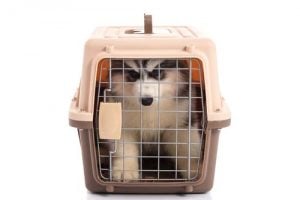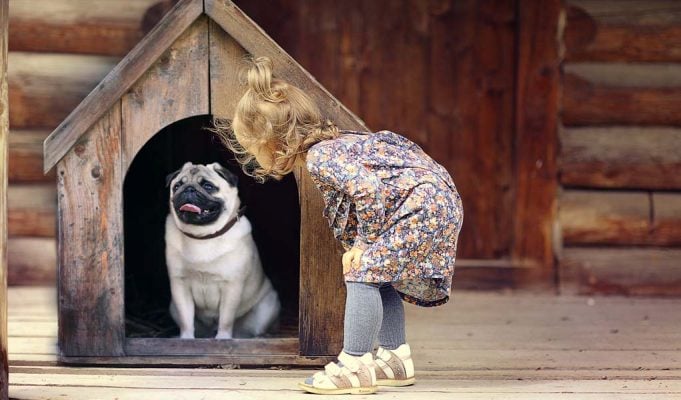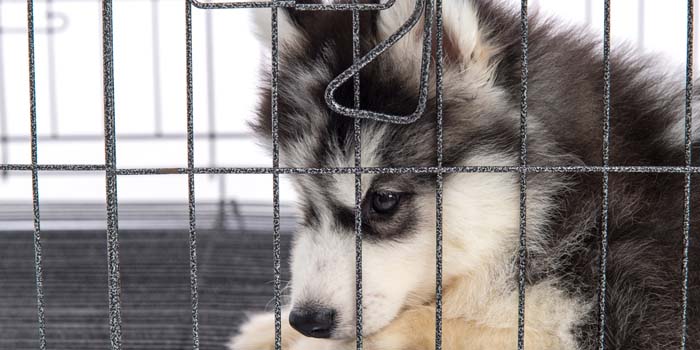After you adopt a pet, it'll be time to take up the training. Unfortunately, housebreaking a dog is one of the most tedious and annoying parts of training dogs, especially teaching them how to stop dog from pooping in house or dog crate.
Crate training a puppy will be of huge help, especially for those pet parents who are often away from home for the most part of the day. It's likely you don't have enough time or even energy to constantly watch your pet making sure he's not doing anything “illegal,” so automating this process is the best way to go.
Even though there are great techniques on how to toilet train your dog, it can prove to be a struggle to teach your dog not to poop or pee in a dog crate or a dog house. As most pet parents will tell you, very few things are as annoying as having to clean the mess out of the kennel every single day.
According to experts, dogs love their crates, and they do make the mess consciously. If you're up for the challenge that will eventually yield very positive results, specifically from crate training your dog, then this article on how to stop dog from pooping in house and in crate will save you time and energy, as well as your dog's crate or house.
MORE TIPS: 9 Ways to Stop a Dog from Pooping in a Crate
How to Stop Your Dog From Pooping in House or Dog Crate
Want to make this simple? Then the most important thing you can do to make the process of crate training your dog and learning how to stop dog from pooping in house is to make sure that everyone in your home is on the same page.
Everybody in your family who communicates with your pooch must be vigilant and strict. Otherwise, the dog will receive mixed signals and won’t have a clear idea of what is right and what is wrong.
You and your family should all follow the exact same schedule as well as the exact same set of commands. This means your canine will learn to not poop in house, crate or even at certain times of the day instead of going sporadically throughout the day, wherever he wants.
RELATED: Grass Litter Boxes vs Housebreaking Training Pads
Correct size of a dog crate or a dog house
 If you're still on the lookout for the proper dog house or the best dog crates for your pooch, make sure you purchase the dog crate that is correct size for your dog.
If you're still on the lookout for the proper dog house or the best dog crates for your pooch, make sure you purchase the dog crate that is correct size for your dog.
Your dog will need enough room to be able to stand up and turn around. If you purchase a crate that is too large, your dog will be able to defecate in one corner and go to sleep in another corner.
Dogs do not want to lie in their own mess, so if the crate isn’t large enough for them to get away from it they will be less likely to use the bathroom, which is one of the primary lessons in learning how to stop dog from pooping in house or in dog crates.
VIDEO GUIDE: How To Choose the Right Size Dog Crate
Consistency and timing must be on point
Timing and a strict schedule are also key in training how to stop dog from pooping in house. This type of consistency will help your pet understand what you want from him, and has been proven as the most effective way not only in housebreaking a dog, but dog training in general.
When you first begin training how to stop dog from pooping in house, you should take your pooch outside to use the bathroom at short intervals throughout the day and gradually build up to a longer time span so that his body can adjust to holding it in.
It is also important to take your dog out shortly after he eats. Feeding your pet before you go to work and then leaving him locked in the dog crate all day is a sure way to be certain you will come home to a mess you'll need to clean up.
RELATED: 10 Lessons on Effectively Crate Training Adult Dog
Monitoring your dog's diet, dog food and water consumption
 Do not forget about not overfeeding your pet with dog food and water while you're crate training him.
Do not forget about not overfeeding your pet with dog food and water while you're crate training him.
You shouldn’t leave dog food available to your pooch all day in the dog crate. Also, make sure to only leave an optimal amount of water in there.
You can leave your dog some pet toys to chew so he doesn't get bored, but he will be fine without any dog food and all it will do is make him more likely to defecate in the crate.
Once your canine is used to holding it in for hours at a time, you can begin leaving small amounts of food (if that's the diet/feeding schedule you're using), and plenty of water in his dog crate with him. Many owners don't do this, but it's an important part of training how to stop dog from pooping in house and in crates.
VIDEO GUIDE: How To Crate Train A Dog Effectively – Step by Step Instructions
Be just as hard on yourself as you are on your dog
Whether you're using a soft sided dog crate, a plastic one or a metal dog crate, the rules apply equally. A trick most people dedicated to crate training and learning how to stop dog from pooping in house use is setting up an alarm to get up periodically and let them out. This means not being a lazy dog parent.
Remember that usually, your dog should have an ample amount of time outside the dog crate during the day or in the evening before you stick him in it for the night. If you crate the dog during the day while you are gone to work and he only has a small window of time to be outside before he goes to bed, it is likely that he will use the bathroom in the dog crate. It's also completely unhealthy for the canine.
Dogs cannot go on command. Sometimes it takes a while for everything to work its way out and they need to have enough time to do their business and get their energy out before they are left in the crate for hours. After some thorough housebreaking training with consistency and dedication, this should not be a problem anymore, however.
WATCH NEXT: How to Stop a Dog From Pooping in a Crate














